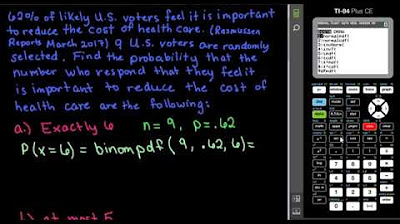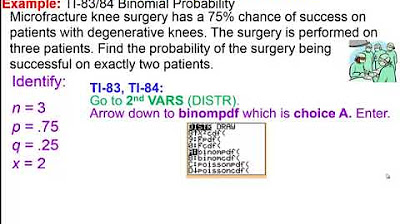5.2.3.1 Binomial Distributions - Use Intuition, A Formula, and Technology to Find Probabilities
TLDRThis video script delves into calculating binomial probabilities using four distinct methods. It begins with the intuitive approach, establishing a foundation for understanding the binomial formula, which is detailed next. The script then transitions to more efficient methods, including the use of technology like Excel, to compute binomial probabilities for scenarios such as guessing on multiple-choice questions. The goal is to demonstrate not only how to calculate these probabilities but also to highlight the practicality of using technology for complex problems.
Takeaways
- 📚 The video discusses four methods for computing binomial probabilities, emphasizing the importance of understanding the intuitive approach before moving on to more efficient methods.
- 🔢 The first method, the intuitive approach, uses the multiplication and addition rules to understand the origin of the binomial probability formula and to interpret binomial probability tables or technology outputs.
- 📉 The binomial probability formula is presented as a complex but essential tool for calculating the probability of x successes in n trials, with p being the probability of success and q the probability of failure in a single trial.
- 🎯 An example is given to illustrate the calculation of the probability of guessing exactly two correct answers out of four multiple-choice questions, using both the intuitive approach and the binomial probability formula.
- 🧩 The intuitive approach involves considering all possible arrangements of correct and incorrect guesses and calculating the probability for each arrangement, then summing these probabilities.
- 📈 The binomial probability formula is shown to produce the same result as the intuitive approach, providing validation for its use in more complex calculations.
- 🛠️ Technology, such as Excel, can be used to calculate binomial probabilities more efficiently, especially for larger datasets or a higher number of trials.
- 📊 The video demonstrates how to use Excel's BINOMDIST function to calculate binomial probability distributions and to find cumulative probabilities for a range of outcomes.
- 📉 An example is provided to show the use of Excel in calculating the probability of getting at least 28 correct answers out of 40 when guessing on a statistics exam.
- 📝 The video emphasizes the impracticality of using the formula method for large-scale problems and the advantages of using technology for such calculations.
- 💡 The final takeaway is the importance of studying and understanding the material rather than relying on chance when it comes to exams, as the probability of success through random guessing is very low.
Q & A
What are the four methods discussed for computing binomial probabilities in the video?
-The four methods discussed are the intuitive approach, using the binomial probability formula, using technology like Excel, and using a table of binomial probabilities.
Why is the intuitive approach considered the least efficient method for computing binomial probabilities?
-The intuitive approach is considered the least efficient because it relies on the multiplication and addition rules and can be time-consuming, especially for problems with a larger number of trials.
What does the binomial probability formula represent and what are its components?
-The binomial probability formula represents the probability of having exactly x successes in n trials, with p being the probability of success on a single trial and q being the probability of failure.
How does the video demonstrate the use of the intuitive approach in an example?
-The video demonstrates the intuitive approach by calculating the probability of getting exactly two correct answers out of four guessed answers on a multiple-choice test, using the multiplication rule.
What is the significance of the binomial probability formula in relation to the intuitive approach?
-The significance of the binomial probability formula is that it provides a more efficient way to calculate binomial probabilities and its derivation is rooted in the intuitive approach, which helps in understanding the origins and validity of the formula.
How does the video use technology to calculate binomial probabilities?
-The video shows how to use Excel to calculate binomial probabilities by inputting the necessary parameters into the BINOMDIST function and demonstrates the process with an example.
What is the probability of guessing exactly two correct answers out of four on a multiple-choice test with five options per question, according to the video?
-The probability of guessing exactly two correct answers out of four is 0.1536 or 15.36%.
How does the video explain the use of Excel for calculating the probability of getting at least 28 correct answers out of 40 on a guessed exam?
-The video explains that by using the BINOMDIST function in Excel with the appropriate parameters (number of trials, number of successes, probability of success, and cumulative probability set to false), one can calculate the probability of getting at least 28 correct answers.
What is the result of using the binomial probability formula to calculate the probability of getting exactly two correct answers out of four?
-Using the binomial probability formula, the result is the same as the intuitive approach, which is 96 out of 625, simplifying to a probability of 0.1536.
What is the probability of getting at least 28 correct answers out of 40 when guessing on a multiple-choice test with four options per question, according to the video?
-The probability of getting at least 28 correct answers out of 40 when guessing is approximately 2.84 * 10^-9, which is very small and indicates it is highly unlikely.
Outlines
📚 Introduction to Binomial Probability Methods
This paragraph introduces learning outcome number three from lesson 5.2, focusing on four methods for calculating binomial probabilities. The first method discussed is the intuitive approach, which uses the multiplication and addition rules. Although it's the least efficient, understanding this approach is crucial for grasping the underlying principles of the binomial formula and interpreting binomial probability tables or technology outputs. The paragraph also briefly mentions other methods, such as using a formula, technology, and probability tables, before diving into an example using the intuitive approach and the binomial probability formula.
🧩 Exploring the Intuitive Approach and Binomial Formula
The speaker elaborates on the intuitive approach to binomial probabilities, explaining how to calculate the probability of guessing correctly on multiple-choice questions. They provide a detailed example where a student guesses on four questions with five possible answers each and want to find the probability of getting exactly two correct answers. The paragraph walks through the process of using the multiplication rule to find the probability of specific arrangements of correct and incorrect answers and then sums these to find the total probability of getting two correct answers out of four. The binomial probability formula is also introduced, showing how it relates to the intuitive approach and providing a mathematical representation of the same scenario.
📈 Applying the Binomial Probability Formula
This section delves deeper into the binomial probability formula, explaining its components and how it's derived from the multiplication and addition rules. The formula is broken down to show the probability of x successes in n trials, with p representing the probability of success and q the probability of failure in a single trial. The paragraph emphasizes the importance of understanding the formula's derivation to trust its application. It also demonstrates how the formula can be used to calculate the probability of exactly two successes in four trials, showing that it yields the same result as the intuitive approach, thus validating the formula's accuracy.
🖥️ Utilizing Technology for Binomial Probability
The speaker introduces technology as a more efficient method for calculating binomial probabilities, particularly for larger datasets. They provide an example of using a TI-83/84 Plus calculator, Excel, Minitab, and Stat Disk to find binomial probabilities for a scenario with five trials and a success probability of 0.85. The paragraph explains how to interpret the output from these technologies, which display the probability distribution in a table format. The focus then shifts to teaching how to use Excel to create a binomial probability distribution, emphasizing its relevance due to the widespread use of Microsoft Office in professional settings.
📝 Example Calculation Using Excel
This paragraph provides a step-by-step guide on how to use Excel to calculate binomial probabilities. The example scenario involves a statistics exam with 40 multiple-choice questions, where the student guesses on all questions and wants to find the probability of getting at least 28 correct answers. The speaker explains the process of inputting the number of trials (n=40), the probability of success in a single trial (p=0.25), and using Excel's binomial distribution function to calculate the probability of getting a certain number of successes. The paragraph highlights the ease of using Excel for such calculations and the importance of using technology for efficiency.
📉 Conclusion on the Probability of Success by Guessing
The final paragraph concludes the discussion on calculating binomial probabilities, particularly focusing on the low probability of guessing correctly on a large number of multiple-choice questions. The speaker reiterates the importance of studying and understanding the material rather than relying on chance when taking an exam. They summarize the three methods introduced: the intuitive approach, the binomial probability formula, and the use of technology, emphasizing the practicality and efficiency of using technology for complex calculations.
Mindmap
Keywords
💡Binomial Probabilities
💡Multiplication Rule
💡Addition Rule
💡Intuitive Approach
💡Binomial Probability Formula
💡Excel
💡Technology
💡Combination
💡Cumulative Probability
💡Multiple Choice Questions
💡Probability of Success
Highlights
The video discusses four methods for computing binomial probabilities, emphasizing their applications and understanding.
The first method, the intuitive approach, is based on the multiplication and addition rules, providing foundational insights but being the least efficient.
The intuitive approach helps validate the binomial probability formula and understand binomial probability tables or technology outputs.
The binomial probability formula is introduced, involving 'n' for trials, 'x' for successes, 'p' for success probability, and 'q' for failure probability.
The formula's components are derived from the multiplication and addition rules, offering a structured way to calculate probabilities.
An example problem is presented involving guessing on standardized test questions, calculating the probability of getting exactly two out of four correct.
The multiplication rule is applied to find the probability of specific sequences of correct and incorrect answers.
The concept of combinations is introduced to calculate the number of ways to arrange two correct answers out of four questions.
The binomial probability formula is shown to produce the same result as the intuitive approach, reinforcing its validity.
Technology use is suggested for more efficient calculations, with a focus on Excel for its accessibility and workplace utility.
Excel's binomial distribution function is explained, demonstrating how to input the required parameters for probability calculations.
An example is given on using Excel to calculate the probability of guessing correctly on at least 28 out of 40 questions on an exam.
The importance of studying and understanding the material is emphasized over relying solely on guessing for exam success.
The video concludes by summarizing the three methods: intuitive approach, binomial probability formula, and technology use, highlighting the practicality of each.
Transcripts
Browse More Related Video

5.2.3.2 Binomial Distributions - Find binomial probabilities using a table.

5.2.5 Binomial Probability Distributions - Using Probabilities to Determine Significance

Binomial Probability Using the TI-84

8.2.3 Testing a Claim About a Proportion - Exact Method Using the Binomial Distribution

Elementary Statistics - Chapter 5 Binomial Distributions Part 2

Math 119 Chapter 5 part 2
5.0 / 5 (0 votes)
Thanks for rating: